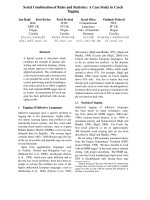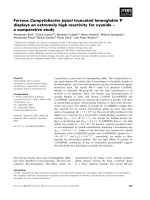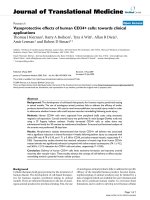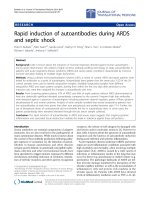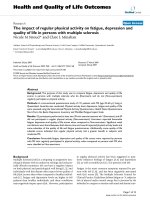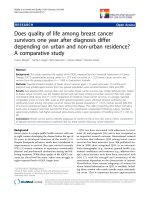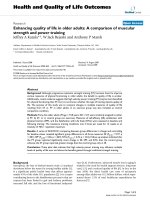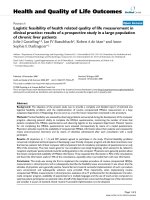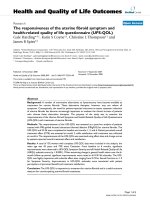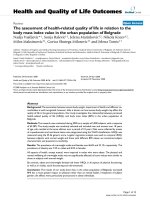báo cáo hóa học: " Health-related quality of life of patients following selected types of lumbar spinal surgery: A pilot study" ppt
Bạn đang xem bản rút gọn của tài liệu. Xem và tải ngay bản đầy đủ của tài liệu tại đây (347.88 KB, 11 trang )
BioMed Central
Page 1 of 11
(page number not for citation purposes)
Health and Quality of Life Outcomes
Open Access
Research
Health-related quality of life of patients following selected types of
lumbar spinal surgery: A pilot study
Karen L Saban*
1
, Sue M Penckofer
1
, Ida Androwich
1
and Fred B Bryant
2
Address:
1
Niehoff School of Nursing, Loyola University Chicago, Chicago, IL, USA and
2
Department of Psychology, Loyola University Chicago,
Chicago, IL, USA
Email: Karen L Saban* - ; Sue M Penckofer - ; Ida Androwich - ;
Fred B Bryant -
* Corresponding author
Abstract
Background: Over 500,000 spinal surgeries are performed annually in the United States.
Although pain relief and improved health-related quality of life (HRQOL) are expectations
following lumbar spinal surgery, there is limited research regarding this experience from the
individual's perspective. In addition, no studies have examined the HRQOL of persons who have
had this surgery using a comprehensive approach. The intent of this study was to address this
deficiency by an assessment of both the individual and environmental factors that impact perceived
HRQOL using the Wilson and Cleary Model for Health-Related Quality of Life in persons who have
undergone lumbar spinal surgery.
Methods: This was a pilot study of 57 adult patients undergoing elective lumbar spinal surgery for
either herniated disk and/or degenerative changes. Individuals completed questionnaires measuring
perceived pain, mood, functional status, general health perceptions, social support and HRQOL
preoperatively and three months following surgery. Descriptive statistics, dependent t-tests, and
MANOVAs were used to describe and compare the differences of the study variables over time.
Results: Preliminary results indicate overall perceived physical HRQOL was significantly improved
postoperatively (t [56] = 6.45, p < .01), however, it was lower than the published norms for patients
with low back pain. Both functional disability (t [56] = 10.47, p < .001) and pain (t [56] = 10.99, p
< .001) were significantly improved after surgery. Although levels of fatigue and vigor were also
significantly improved after surgery, both were less than the published norms. There was no change
in the level of social support over time; however, level of support was consistent with that reported
by patients with chronic illness.
Conclusion: Although perceived physical HRQOL was significantly improved three months
postoperatively, fatigue and lack of vigor were issues for subjects postoperatively. Excessive fatigue
and low vigor may have implications for successful rehabilitation and return to work for patients
following lumbar spinal surgery. Further research is needed with a larger sample size and subgroup
analyses to confirm these results.
Published: 28 December 2007
Health and Quality of Life Outcomes 2007, 5:71 doi:10.1186/1477-7525-5-71
Received: 26 July 2007
Accepted: 28 December 2007
This article is available from: />© 2007 Saban et al; licensee BioMed Central Ltd.
This is an Open Access article distributed under the terms of the Creative Commons Attribution License ( />),
which permits unrestricted use, distribution, and reproduction in any medium, provided the original work is properly cited.
Health and Quality of Life Outcomes 2007, 5:71 />Page 2 of 11
(page number not for citation purposes)
Background
Lumbar spinal surgery is one of the most common types
of surgeries performed in the United States with over
500,000 surgeries performed for lumbar herniated disks
and lumbar spinal stenosis in 2004 [1]. Numerous studies
have reported the clinical outcomes of spinal surgery.
However, many studies have defined success rates in
terms of medically-related outcomes, such as fusion rates
and radiographic evidence, rather than the patient's per-
spective. Studies have demonstrated that patients' per-
spectives of their clinical outcomes are not necessarily the
same as those of their clinicians'[2]. Although pain relief
and improved health-related quality of life (HRQOL) are
patient expectations following lumbar spinal surgery,
there is limited research regarding this experience from
the individual's perspective. In addition, no studies have
examined the HRQOL of persons who have had this sur-
gery using a comprehensive approach. The intent of this
study was to address this deficiency by an assessment of
both the individual and environmental factors that
impact perceived HRQOL, using the Wilson and Cleary
Model for Health-Related Quality of Life, in persons who
have undergone lumbar spinal surgery.
Using a framework in quality of life research is important
because it promotes the selection of appropriate measure-
ment variables and identifies potential links between var-
iables within the complex construct of quality of life.
Wilson and Cleary published their conceptual model of
quality of life in JAMA
in 1995 [3] and it was later revised
by Ferrans et al [4] (Figure 1). This model was developed
in order to help explain the relationships of clinical varia-
bles that relate to quality of life. The authors of the model
present it as taxonomy of patient outcomes that link the
characteristics of the individual to the characteristics of
the environment. The model proposes causal linkages
between five different types of patient outcome measure-
ments. The first variable, the biological and physiological
variable is considered the most basic. It includes such
measurements as laboratory tests, blood pressure and
physical examination. The second variable is symptom
status. It consists of physical, emotional and psychologi-
cal symptoms that the patient may subjectively experi-
ence. The third variable in the model is functional status
which refers to the patient's ability to perform certain
tasks or functions. Functional status is usually subjectively
reported by the patient but can also be assessed by others.
The fourth variable, general health perceptions is the glo-
bal perception of the individual of his general health state
and takes into account the weights and values that the
patient attaches to symptoms or functional abilities.
Finally, QOL is the patient's overall satisfaction with life.
The arrows represent dominant causal relationships.
Reciprocal relationships between the variables are recog-
nized to exist but are not represented. Since the revised
Wilson and Cleary model incorporates individual charac-
teristics with environmental characteristics, it is a useful
model for guiding QOL research, especially in patients
with lumbar spinal disease since their recovery may be
affected by both internal factors (such as physiological
Revised Wilson and Cleary Model for Health-Related Quality LifeFigure 1
Revised Wilson and Cleary Model for Health-Related Quality Life. Revised Wilson and Cleary Model for Health-
Related Quality of Life. Ferrans, C. E., Zerwic, J. J., Wilbur, J. E., & Larson, J. L. (2005). Conceptual model of health-related qual-
ity of life. Journal of Nursing Scholarship, 37, 336–342. Adapted from Wilson, I.B., & Cleary, P.D (1995). Linking Clinical Variables
with Health-Related Quality of Life: A Conceptual Model of Patient Outcomes. JAMA. 273, 59–65. Copyright JAMA. Used with
permissions.
Health and Quality of Life Outcomes 2007, 5:71 />Page 3 of 11
(page number not for citation purposes)
variables, personality, values and preferences) as well as
characteristics of the environment (such as social sup-
port).
Characteristics of individual
Several socio-demographic variables are associated with
the incidence as well as treatment outcome of patients
with low back pain. For instance, patients with higher lev-
els of education tend to have a decreased risk of develop-
ing low back pain [5]. This finding may be related to type
of work of patients with higher levels of education having
less physically labor intensive jobs. Some studies have
correlated demographic information with clinical out-
comes of lumbar spinal surgery. For instance, one study
reported that subjects who reported the best improve-
ments in physical functioning and ability to walk after sur-
gery were male and younger [6]. Race was uncommonly
reported in the spinal surgery literature. However, in the
published studies where race was reported, racial disparity
existed with most samples being predominately white [7].
Characteristics of environment
Degree of social support is considered to represent an
aspect of the environment in the revised Wilson and
Cleary model of HRQOL [4]. Although several studies
have considered the role of social support in recovery and
HRQOL outcomes [8], only one study was found that
examined social support as a predictor of the surgical out-
come of patients undergoing spinal surgery [9]. This
study, although it did not specifically measure quality of
life, found that subjects who had severe psychological
strain and lack of social support had poor surgical out-
comes.
Biological function
Some studies have demonstrated that subjects with
chronic low back pain tend to be sicker than the general
population with a higher incidence of associated comor-
bidities such as depression, anxiety, sleep disturbances,
and headaches [10,11]. Hestbaek et al [11], suggested
that, based on a literature review of comorbidities and low
back pain, that low back pain may be part of a disease
cluster in some individuals. Other studies have not found
a higher incidence of comorbidities in back sufferers [5].
In addition, obesity has been associated with poorer out-
comes of spinal surgery [12] due to difficulties in mobiliz-
ing after surgery as well as impaired wound healing.
Symptoms: pain and mood
The primary complaints of patients undergoing lumbar
spinal surgery are back pain and radicular pain accompa-
nied by leg weakness. The goal of spinal surgery is to either
completely alleviate pain or to greatly minimize it.
Numerous studies have reported measures of level of pain
before and after lumbar spinal surgery [13]. Postoperative
reports of pain in the literature varied depending upon
such factors as the type and extent of surgery, comorbidi-
ties, and time since surgery. However, most studies
reported improvement in pain postoperatively. For exam-
ple, in one prospective study of 281 patients who under-
went lumbar surgery for degenerative changes, herniated
disks, instability, or spinal stenosis, 80% reported that
their pain intensity level had improved at least moderately
one year after surgery [14].
The literature related to other symptoms (such as depres-
sion and anxiety) in patients undergoing lumbar spinal
surgery was much less robust than the pain literature.
Although there is literature to suggest that back pain is
often associated with mood disorders [15], no studies
were found that considered whether or not mood
improved after lumbar spinal surgery.
Functional status
Wilson and Cleary [3] defined functional status as the
ability of the patient to perform certain tasks and func-
tions. The functional status variable includes physical
functioning, social functioning, emotional functioning
and role functioning. Functional status has been meas-
ured as both a predictor variable and outcome measure-
ment in the spinal surgery population. Many studies have
reported improvement in functional status of patients
undergoing lumbar spinal surgery [16]. However, func-
tional status as an outcome variable is often measured in
terms of the ability to return to work [7,17]. Most of these
studies found return to work status to be highly variable
and dependent upon such factors as preoperative disabil-
ity level, age, type of work and type and extent of surgical
procedure.
General health perceptions
According to Wilson and Cleary [3], general health per-
ceptions take into account satisfaction with health as well
as how symptoms and functional abilities are valued. No
studies were found that specifically measured health per-
ceptions in patients undergoing lumbar spinal surgery.
Health-related quality of life
A number of studies were conducted measuring the
HRQOL in patients undergoing spinal surgery [18]. The
most common measures of HRQOL in these studies were
the SF-36 [19], the Roland Morris Disability Question-
naire [20], and the Stauffer-Coventry Index [21]. Overall,
research indicated that patients undergoing lumbar spinal
surgery did demonstrate improvements in HRQOL post-
operatively. However, there was wide variance in how
HRQOL was conceptualized and measured. In addition,
no studies were found that evaluated HRQOL within a
comprehensive framework. Therefore, the overall purpose
of this study was to address this deficiency by examining
Health and Quality of Life Outcomes 2007, 5:71 />Page 4 of 11
(page number not for citation purposes)
HRQOL of patients undergoing lumbar spinal surgery
guided by the revised Wilson and Cleary QOL Model [4].
Methods
Design
This longitudinal one-group pretest-posttest study was
part of a larger study that examined the relationships
between changes in social support, pain, mood, func-
tional status, perceived health status, patient expectations,
optimism, and perceived QOL of subjects undergoing
lumbar spinal surgery for either herniated disk and/or
degenerative changes [22,23]. This report focuses on the
changes in social support, pain, mood, functional status,
perceived health and perceived HRQOL after lumbar spi-
nal surgery.
Setting and sample
Using a consecutive convenience sample, the study was
conducted at five Midwestern hospitals in the United
States. Surgical technique and procedures were considered
similar among these sites. The inclusion criteria were
patients undergoing elective lumbar spinal surgery for the
first time for degenerative changes and/or herniated disks,
age 18 years or older, with the ability to read and write
English. Patients undergoing lumbar spinal surgery for
degenerative changes and/or herniated disks were chosen
because they were expected to make at least some symp-
tom and functional improvements by 3 months postoper-
atively. Patients with cancer, spinal cord injury, cauda
equina syndrome, and more than two levels of fusion
were excluded from the study in order to control for sig-
nificantly different recovery trajectories. Both genders as
well as different ethnic groups were included in the study
based upon meeting the inclusion criteria.
Ninety-four patients were approached for participation in
the study. Of these, 73 (77.6%) completed the preopera-
tive questionnaire. Postoperatively, 57 (78%) subjects
completed the follow up questionnaire resulting in a total
sample size of 57 for analysis.
Procedure
The study was approved by the university and hospital
institutional review boards. A one-page information sheet
inviting patients who met the inclusion criteria to partici-
pate in the study was made available in waiting rooms
and exam rooms. In addition, potential subjects were
identified by the surgeons and clinic nurses.
Potential subjects were informed of the purpose, risk/ben-
efits of the study, and were invited to participate in the
study. After obtaining informed consent, subjects com-
pleted a preoperative questionnaire booklet 2–14 days
prior to surgery and then a postoperative questionnaire
booklet approximately 3 months after surgery.
Variables and instruments
The revised Wilson and Cleary Model for Health-Related
Quality of Life [4] provided the basis for the selection of
the variables studied. The variables and their correspond-
ing measurements tools are summarized in Table 1.
Characteristics of the individual
The investigator developed a demographic form to collect
subject demographic information such as patient age,
gender, marital status, race, work status, and educational
level.
Characteristics of the environment
The Medical Outcomes Study (MOS) Social Support Sur-
vey [24] was used to measure perceived availability of
social support. The MOS is a structured, self-report ques-
tionnaire with responses to each item given on a 5-point
Likert scale from 1 = none of the time to 5 = all of the
times. The total score generated from nineteen items was
used in the analysis for this study. In the initial study
using the MOS in 2987 subjects, the total Cronbach's
alpha was 0.97 [24]. The MOS demonstrated excellent
test-retest reliability (0.78) taken at a one-year interval
and high convergent and discriminant validity [24]. No
studies were found that used the MOS in the spinal sur-
gery population, however the tool seemed be appropriate
for this group of subjects. For this study, Cronbach's alpha
Table 1: Health-Related Quality of Life Variables
Revised Wilson and Cleary HRQOL Concepts Study Variable Measurement Tool
Characteristics of individual Age, gender, marital status Demographic questionnaire
Characteristics of environment Social support Medical Outcomes Study – Social Support
Biological function Type of surgery, number of spinal levels, BMI Medical Chart Review, Medical History Form
Symptoms Mood Profile of Moods State (POMS-Brief)
Pain Numeric Pain Rating Scale
Functional status Disability level Oswestry Disability Index for Low Back Pain
General health perceptions Overall health Overall health item
Quality of life Perceived physical HRQOL SF-12 Physical component summary
Perceived mental HRQOL SF-12 Mental health component summary
Health and Quality of Life Outcomes 2007, 5:71 />Page 5 of 11
(page number not for citation purposes)
coefficients for the total scores for the MOS were good
(preoperatively 0.95 and postoperatively 0.96).
Biological function
A medical chart review form was developed by the inves-
tigator to collect biological and physiological variables
pertinent to this study including comorbidities, presence
of obesity as measured by body mass index over 30, and
type of surgery.
Symptom status: pain and mood
The Numeric Pain Rating Scale (NPRS) was used to assess
degree of back pain. The NPRS is a 0 to 10 point scale in
which 0 is considered no pain and 10 is the worst pain
possible. The instrument has been used extensively in a
wide variety of settings and has been validated with low
back pain patients [25]. Level of pain was measured both
preoperatively and postoperatively.
The Profile of Mood States-Brief Form (POMS-Brief) [26]
was used to assess affective mood states. The POMS-Brief,
developed from the longer 65-adjective POMS, is a com-
monly used measure of psychological distress and has
been found to be particularly useful in measuring changes
in mood over time and therefore was appropriate in this
longitudinal study. The 30-adjective POMS-Brief exam-
ines the same six mood states of the longer POMS: Ten-
sion-Anxiety, Depression-Dejection, Anger-Hostility,
Vigor-Activity, Fatigue-Inertia and Confusion-Bewilder-
ment. Scores for each of the six subscales range from 0–20
with higher scores indicating higher distress except for the
subscale of Vigor-Activity which is negatively scored. A
total mood score is obtained by adding the scale scores of
Tension-Anxiety, Depression-Dejection, Anger-Hostility,
Fatigue-Inertia, and Confusion-Bewilderment and sub-
tracting the scale score of Vigor-Activity. The total mood
score ranges from 0–80 (from least disturbed to most dis-
turbed). According to the POMS Manual, internal consist-
ency estimates for the POMS were found to be satisfactory
nearing .90 or above [26]. Test-retest reliability coeffi-
cients were reported to range from .61 to .69 [27]. For this
study, reliability for the total mood disturbance scores
were good (preoperative Cronbach's alpha = 0.90 and
postoperative Cronbach's alpha = 0.92) and were consist-
ent with those reported in previous studies [26,28].
Functional status
Disease-specific functional status was measured using the
Oswestry Disability Index for Low Back Pain (ODI) Ver-
sion 2.0 [29]. The ODI is a self-administered tool that
consists of 10 items, each with six possible choices rang-
ing from normal functioning to inability to function. The
ODI measures the patient's ability to function in areas of
daily living that are most likely impaired by patients suf-
fering from low back pain such as ability to walk and lift
objects. The total score provides a disability score: 1) 0–20
= Minimal disability; 2) 20–40 = Moderate disability; 3)
40–60 = Severe disability; 4) 60–80 = Crippled and 5)
80–100 = Bed-bound or exaggerating symptoms.
Test-retest scores with an interval of 4 days was found to
be high (r = 0.91) [30]. Internal consistency using Cron-
bach's alpha was shown to be acceptable ranging from
0.71 to 0.87 in a number of studies i.e. [30]. For this study,
Cronbach's alpha was good (0.78 preoperatively and 0.80
postoperatively).
General health perceptions
General health perceptions were evaluated at each time
point with a single item that asked the respondent to rate
their overall health as "excellent", "very good", "fair" or
"poor". Studies have supported the reliability and validity
of using a single-item indicator to measure such variables
as well-being and health perceptions [31].
Health-related quality of life
Health-related quality of life was measured with the
SF12v2 [32]. The SF12v2 is a generic measure that consists
of 12 items and provides scores for eight health concepts
as well as two summary outcomes for physical health and
mental health. The SF12v2 was derived from the SF-36,
one of the most widely used health surveys in the world
[32].
Published reliability coefficients range from 0.73 to 0.87
across all eight subscales of the SF-12v2 [32]. For the two
summary scales, PCS-12 and MCS-12, reliability estimates
were 0.89 and 0.86 respectively. No studies were found
that used the SF-12 or SF-12v2 in the spinal surgery pop-
ulation; however, many studies have used the SF-36.
The authors of the S12v2 recommend intraclass correla-
tions for estimating test-retest reliability for the SF-12 PCS
and MCS [32]. For this study, test-retest reliability based
on intraclass correlations between preoperative and post-
operative measurements were PCS = 0.44 and MCS = 0.47.
These reliabilities may be low due to a change in the
patients' health after surgery as well as a three-month
period between test administrations.
Data analysis
Data was entered into the statistical analysis program,
SPSS 14.0 (SPSS Inc., Chicago, IL) for each instrument.
Missing data per subject ranged from 0.5% to 11.3% with
a mean of 2.9% (N = 57). Upon examination of each
question, no patterns of missing data were noted. Missing
data in key variables were replaced with values using a
multiple imputation procedure based upon a regression
model.
Health and Quality of Life Outcomes 2007, 5:71 />Page 6 of 11
(page number not for citation purposes)
Descriptive statistics, dependent t-tests, and analysis of
variance (ANOVA) were used to describe and compare
differences between the preoperative and postoperative
variables. Multivariate analysis of variance (MANOVA)
was used to detect changes over time in subscales.
Results
Characteristics of individual
Subjects (N = 57) averaged 53.4 years of age with age rang-
ing from 21 to 84 years old. For patients undergoing sur-
gery for primarily herniated disk(s), (N = 34, 60%), the
mean age was lower (M
= 48.81, SD = 12.93). As expected,
the mean age for patients undergoing surgery for spinal
stenosis and degenerative changes (N = 10, 17%) was
higher (M
= 65.7, SD = 6.61). Patients undergoing lumbar
fusion (N = 13, 23%) had a mean age of 56.53 (SD =
11.30). There were slightly more women (N = 30, 52.6%)
than men (N = 27, 47.4%) who participated in the study.
Most subjects were married (N = 40, 70.2%). The majority
were white (N = 51, 89.5%) and had at least some college
education. Only 19.3% (N = 11) of participants were
working full-time without any restrictions prior to sur-
gery. Preoperatively, 36.8% (N = 21) of subjects indicated
that they had decreased their work hours or were not able
to work because of their back problem.
Characteristics of environment
The variable of social support represented an aspect of the
characteristic of the environment in the model. Overall,
subjects reported moderate levels of social support both
preoperatively (M = 68.21, SD = 20.91) and postopera-
tively (M = 67.53, SD = 22.90) (Table 2). A paired t-test
revealed no significant difference between the preopera-
tive and postoperative MOS total scores (t [54] = .132, p =
.895).
Biological function
Subjects reported a wide variety of comorbidities includ-
ing hypertension (33.3%, N = 19), osteoarthritis (21%, N
= 12), and diabetes (10.5%, N = 6) being the most com-
mon. Most subjects were either overweight or obese
(70.2%, N = 40), which is a common risk factor in the
development of back pain. The type of surgical procedures
performed included lumbar microdiscectomy (N = 34,
59.7%), lumbar fusion (N = 13, 22.8%) and lumbar lam-
inectomy (N = 10, 17.5%). Most participants (N = 41,
71.9%) had only one spinal segment operated on and the
majority (N = 46, 80.7%) did not require instrumenta-
tion.
Table 2: Preoperative and Postoperative Results of Quality of Life Variables (N = 57)
Preoperative Postoperative p-Value
Social Support (M, SD) 68.21 ± 20.91 67.53 ± 22.90 .895
Pain (M, SD) 7.00 ± 1.80 3.19 ± 2.30 <.001
Mood (M, SD)
Total Mood 28.57 ± 19.84 16.35 ± 11.98 <.05
Tension 7.36 ± 4.36 4.13 ± 4.12 <.001
Depression 5.18 ± 4.80 4.26 ± 4.85 .469
Anger 5.15 ± 4.60 3.91 ± 4.57 .175
Vigor 4.05 ± 3.75 7.42 ± 4.18 <.001
Fatigue 9.43 ± 5.32 7.12 ± 4.86 <.05
Confusion 5.13 ± 3.11 4.35 ± 3.14 .469
Functional status (M, SD) 51.31 ± 15.48 23.89 ± 15.96 <.001
Overall Health (M, SD) 3.33 ± 1.15 3.36 ± 1.17 .898
HRQOL (M, SD)
Physical Component 29.39 ± 8.10 38.66 ± 11.99 <.001
Mental Component 46.43 ± 11.90 49.99 ± 11.29 .120
Physical Functioning 29.43 ± 9.20 37.62 ± 12.19 <.001
Role Physical 30.85 ± 8.22 38.66 ± 11.04 <.001
Bodily Pain 29.05 ± 9.06 41.68 ± 11.05 <.001
General Health 44.01 ± 12.45 46.40 ± 13.99 .136
Vitality 41.16 ± 9.92 44.69 ± 14.69 <.05
Social Functioning 37.09 ± 12.31 45.69 ± 12.14 <.001
Role Emotional 41.76 ± 12.37 44.41 ± 12.11 .131
Mental Health 42.60 ± 11.90 47.67 ± 11.62 <.05
* Bolded text is significant
Health and Quality of Life Outcomes 2007, 5:71 />Page 7 of 11
(page number not for citation purposes)
Symptom status: pain and mood
The variables of pain and mood corresponded to symp-
tom status in this study. The Numeric Pain Rating Scale
(NPRS) was used to measure degree of pain on a scale of
0 to 10 with 0 being no pain and 10 being extreme pain.
Pain decreased from a mean of 7.0 preoperatively to a
mean of 3.19 postoperatively (Table 2). The decrease in
pain from the preoperative to the postoperative period
was significant (t [56] = 10.99, p < .001).
The POMS-Brief Form was administered both preopera-
tively and postoperatively to measure mood. The overall
total mood disturbance score was calculated as well as six
subscales measuring tension-anxiety, anger-hostility,
vigor-activity, fatigue-inertia, confusion-bewilderment,
and depression-dejection (Table 2). A paired t-test
revealed that there was a significant improvement
between preoperative total mood and postoperative total
mood (t [56] = -4.009, p < .001). A repeated measures
general linear model was used to test for differences
between time periods on the subscales. Results indicated
an overall difference within subjects for time (F [6,45] =
12.257, p < .001. Univariate analysis revealed that the
subscale scores of tension (F [1, 50] = 21.345, p < .01),
vigor (F [1, 50] = 25.714, p < .01), and fatigue (F [1, 50] =
4.613, p < .05) significantly improved from the preopera-
tive to postoperative time periods. There were no signifi-
cant differences between time periods for anger,
confusion, and depression (Table 2).
Functional status
Preoperatively, the ODI mean was 51.3 indicating severe
disability in functional status (Table 2). Postoperatively,
the ODI mean improved significantly (t [56] = 10.472, p
< .001) to 23.89 indicating moderate disability in func-
tional status.
General health perceptions
General health perception did not change significantly
between the preoperative and postoperative periods
(Table 2) (t [56] = 129, p = .898).
Health-related quality of life
Health-related quality of life was measured with the SF-
12v2 that elicited a summary score for Physical Compo-
nent Summary (PCS-12) and Mental Component Sum-
mary (MCS-12). In addition, eight subscale scores
(physical functioning, role physical, bodily pain, general
health, vitality, social functioning, role emotional and
mental health) were calculated for both the preoperatively
and postoperative data. Means for the summary scores as
well as all eight subscales improved from the preoperative
to postoperative period (Table 2). A paired t-test demon-
strated a significant improvement in the PCS (t [56] = -
6.454, p < .001). However, no significant differences were
found between the preoperative and postoperative MCS (t
[56] = -1.519, p = .120). A repeated measures general lin-
ear model was used to calculate differences between time
periods on each of the eight subscales. Results indicated
that there was an overall significant difference within sub-
jects between preoperative and postoperative time periods
(F [8, 49] = 7.677, p < .001). Univariate analysis revealed
significant differences between time periods for the phys-
ical functioning (F [1,56] = 27.917, p < .01), role physical
(F [1,56] = 28.283, p < .01), bodily pain (F [1,56] =
64.150, p < .01), social functioning (F [1,56] = 22.318, p
< .01), and mental health (F [1,56] = 10.769, p < .01). The
subscales of general health, vitality and role emotional
did not show significant differences between the time
periods.
Discussion
A strength of this study is that it is the first study to exam-
ine the HRQOL in persons following lumbar spinal sur-
gery using a theoretical framework. According to the
revised Wilson and Cleary's Model for Health-Related
Quality of Life [4], the biomedical paradigm, which
focuses on disease and pathology, is linked to the social
science paradigm that encompasses dimensions of func-
tional abilities and overall well-being. In this study, spinal
disease not only affected the subject's physiological proc-
esses, but also influenced the social paradigm of both role
and functional abilities.
Characteristics of the sample (individual and biologic
function) were similar to other studies of patients under-
going lumbar spinal surgery in terms of reported preva-
lence of obesity [33] and most commonly associated
comorbidities [34]. The demographics of the study sam-
ple were also similar to other studies of spinal surgery
patients in relation to age, marital status, educational sta-
tus, race [7], and gender [18]. The wide age range (21 to
84 years) of subjects in this study may have had implica-
tions for HRQOL results. Age was somewhat positively
correlated (r = .351, p < .01) with the Mental Health Com-
ponent (MCS) of the SF-12v2 but was not significantly
correlated with the Physical Component Summary (PCS)
score (r = .157, p > .05). In other words, older subjects
tended to report higher levels of mental health HRQOL
but age did not seem to make a difference in terms of
physical HRQOL. The finding that age is positively corre-
lated with higher levels of mental HRQOL is consistent
with the literature of older persons in the general popula-
tion reporting higher levels of overall HRQOL and well-
being than younger persons [35]. Other studies have
reported that older age is negatively correlated with phys-
ical HRQOL of patients undergoing lumbar spinal surgery
[6,7,36,37]. It may be that these differences were not able
to be detected because of our small sample size. More
Health and Quality of Life Outcomes 2007, 5:71 />Page 8 of 11
(page number not for citation purposes)
research is needed to further examine the role of age as it
related to spinal surgery type and perceived HRQOL.
Race was uncommonly reported in the spinal surgery lit-
erature. However, in the published studies where race was
reported, racial disparity existed with most samples being
predominately white [7]. The sample in this study con-
sisted of 89.5% whites, 8.9% blacks and 1.8% American
Indian. This racial disproportion may be related to health-
care access, resource allocation or the regional demo-
graphics of where the study was conducted. Further
research that considers race is needed in future studies of
spinal surgery outcomes. Of the published studies found
that reported on patients undergoing various lumbar spi-
nal procedures, consistent with this study, the majority of
subjects underwent lumbar microdiscectomies [14]. A
sample consisting of subjects undergoing only one type of
lumbar surgery (i.e. lumbar microdiscectomy) would
have been ideal. In addition, it was suggested in one study
that compared quality of life between subjects undergoing
surgery for decompression for spinal surgery with spinal
instrumentation (N = 15) to those without spinal instru-
mentation (N = 8) that the use of spinal instrumentation
may positively influence postoperative HRQOL [38] by
allowing for better fusion rates. It may be important in
future studies to conduct subgroup analysis considering
various types of surgeries and use of spinal instrumenta-
tion using sample sizes that are adequately powered.
In terms of environment, to the authors' best knowledge,
this study is the first to use the Medical Outcomes Study
(MOS) Social Support Survey to measure level of social
support in patients undergoing lumbar spinal surgery.
Only one study was found that examined social support as
a predictor of surgical outcome of lumbar discectomy and
found that subjects who had severe psychological strain
and lack of social support had poor surgical outcomes [9].
Level of social support has also been found to positively
influence compliance with prescribed medical regimens
[39] as well as overall quality of life in patients undergo-
ing surgery [40]. In contrast, social support has also been
found to negatively influence outcomes after lumbar spi-
nal surgery if the family member excessively reinforces the
pain [41] or the patient overly relies on available support
[42]. A comparison of mean scores for the MOS suggests
that lumbar spinal surgery patients in this study reported
moderately high levels of social support similar to
patients with chronic conditions (M = 70.1) [24]. Interest-
ingly, level of social support did not change after surgery
in contrast to a study of patients who underwent cardiac
surgery who exhibited significantly decreased levels of
social support three months after surgery [8]. The finding
in this study may be attributed to possible differences in
the levels of associated comorbidities and/or surgical
recuperation of these two populations. On the other
hand, social support levels remaining high after back sur-
gery may be an indication of an over reliance on social
support systems. Additional research considering the fam-
ily or caregiver's perspective may be important to consider
in future studies.
Although functional status was significantly improved
after surgery, subjects remained moderately disabled three
months after surgery. This finding is consistent with the
literature regarding spinal surgery [43]. Yukawa et al [43]
reported that in a study of 62 subjects who underwent a
laminectomy for spinal stenosis, functional status was sig-
nificantly improved 6 to 18 months postoperatively. Sim-
ilar improvements in functional status were reported in a
study of patients following anterior lumbar fusion [44].
Further research is needed to clarify the expected time of
optimal functional recovery following different types of
spinal surgery.
In terms of symptom status, subjects experienced signifi-
cant improvement in pain relief following surgery. This is
also supported by other studies of spine surgery patients
that examined pain relief [45]. Jang & Lee [45] reported
that in a sample of subjects undergoing minimally inva-
sive lumbar fusion level of pain as measured on the NPRS
significantly improved from a score of 7.5 to 2.3 postop-
eratively. However, no studies were found that considered
the quality, duration and frequency of pain as well as use
of pain relieving medications in the months following
spine surgery. A more comprehensive measurement of
pain may be important in future studies of patients under-
going spinal surgery.
Despite overall mood being significantly improved after
surgery, subjects still reported lower levels of vigor and
higher levels of fatigue as compared to published norms
[26]. This may have been a result of continued recovery
from surgery at 3 months postoperative or it could have
been related to subjects feeling greater fatigue as they
returned to normal activities. Some studies have found
that chronic low back pain is associated with higher rates
of mood disturbances [15]. No studies were found that
considered whether or not mood improved after lumbar
spinal surgery.
In the current study, the postoperative total mood distur-
bance score was slightly higher than a sample of patients
who had undergone coronary artery bypass surgery one
month previously [46] and patients undergoing cardio-
verter defibrillator implantations [47]. These variances in
scores may be related to differences in age and comorbid-
ities among the groups or could be a reflection of the
higher rates of mood disturbances found in chronic low
back pain patients.
Health and Quality of Life Outcomes 2007, 5:71 />Page 9 of 11
(page number not for citation purposes)
Overall perceived health was unchanged after surgery
when compare to preoperative level. This finding may be
related to comorbidities. No other studies were found that
reported overall perceived health in the back surgery pop-
ulation. Including a comorbidity measure in future stud-
ies may help clarify the role of comorbidities in perceived
health.
Health-related quality of life as measured by the SF-12v2
was significantly improved after surgery in terms of the
perceived physical component summary (PCS) but not
the perceived mental health summary (MCS). The
improvement in the physical component can be attrib-
uted to decreased level of pain and better functional sta-
tus. However, despite reporting an improved health-
related quality of life three months after surgery, perceived
physical health in this sample was lower than published
norms for patient with low back pain (Figure 2) [32].
These lower scores were attributed to lower levels of phys-
ical function, vitality and physical role functioning when
compared to normative data. Continuing recovery three
months postoperatively may be one explanation for lower
function and vitality as compared to the normative sam-
ple of non-surgical back pain subjects. There did not
appear to be a difference in perceived mental health
between this sample and the normative group.
As postoperative fatigue and lack of vitality were identi-
fied as lower than published norms for both the POMS-
Brief Form and the SF-12v2, further research exploring
levels of fatigue and lack of vitality during recovery from
lumbar spinal surgery may be warranted. In addition it
may be helpful for clinicians to be aware of when patients
are expected to reach maximal improvement in levels of
vitality and energy following lumbar spinal surgery so that
rehabilitation and return to work activities can be appro-
priately timed. Although no studies were found related to
level of fatigue in postoperative lumbar spinal surgery
patients, several studies considered fatigue in patients
with low back pain. For example, Fishbain et al [48] found
that patients with chronic low back pain were significantly
more fatigued than a non-patient control group. Further-
more, Fishbain et al [48] found that higher levels of
fatigue were predicted by pain, female gender, depression
and number of psychiatric comorbidities in chronic low
back pain patients. In another study of 457 patients with
low back pain compared to a normative sample, Hagen et
al [15] found that low back pain sufferers reported more
sleep disturbances related to pain, depression and anxiety.
Causes and comorbidities of fatigue in low back pain
patients may be different than those found in postopera-
tive lumbar spinal surgery patients. However, measure-
ment of sleep disturbances, depression, anxiety, as well as
a comprehensive assessment of pain may be helpful in
determining what factors are associated with fatigue in
lumbar spinal surgery patients. In addition, longitudinal
measurements of fatigue after lumbar spinal surgery may
assist in determining the recovery trajectory in these
patients.
There are several limitations of our study. The most signif-
icant limitation was the small sample size. A larger sample
size may have demonstrated significant improvement in
the mental health component of the SF-12v2. Another sig-
nificant limitation of this study was the inclusion of vari-
ous types of lumbar surgical procedures for herniated
disks, degenerative changes and spinal stenosis. A wide
age range as well as other variables may have influenced
findings. For example, severity of disease and the presence
of comorbidities may have impacted HRQOL ratings. A
more homogeneous group would have allowed for better
interpretation of findings. In addition, future studies
should consider different surgical techniques such as the
increasingly common minimally invasive approach.
Finally, a control group of non-surgical low back pain
patients may be helpful in determining whether or not
changes in measured variables could be attributed to lum-
bar spinal surgery.
Conclusion
Despite its limitations, the findings of this study contrib-
ute to the body of healthcare in several ways. It is the first
known study that considered discrete aspects of HRQOL
within an overall QOL framework in the lumbar spinal
surgery population. Given the complexity of HRQOL
SF12v2 preoperative, postoperative and norm comparisonsFigure 2
SF12v2 preoperative, postoperative and norm com-
parisons. * Indicates p < .05 between preoperative and
postoperative scores. Higher scores reflect higher function-
ing. PF = physical functioning, RP = role-physical, BP = bodily
pain, GH = general health, VT = vitality, SF = social function-
ing, RE = role-emotional, MH = mental health.
Health and Quality of Life Outcomes 2007, 5:71 />Page 10 of 11
(page number not for citation purposes)
measurement, it is important that a QOL framework be
utilized in order to identify important variables to be
measured. In addition, this study identified fatigue as a
possible issue during recovery from lumbar spinal surgery
which may have implications for rehabilitation. Lastly,
the consideration of HRQOL outcomes following lumbar
spinal surgery from the patient's perspective will assist cli-
nicians in better meeting the needs and expectations of
patients during the recovery period.
Abbreviations
ANOVA-Analysis of variance; BMI-Body Mass Index;
HRQOL-Health-Related Quality of Life; MANOVA-Multi-
variate analysis; MCS-Mental Component Summary;
MOS-Medical Outcomes Study Social Support Survey;
NPRS – Numeric Pain Rating Scale; ODI-Oswestry Disa-
bility Index; PCS-Physical Component Summary; POMS –
Profile of Mood States; QOL-Quality of Life
Competing interests
The author(s) declare that they have no competing inter-
ests.
Authors' contributions
KLS: Participated in the conception and design of study,
coordinated the study and drafted manuscript.
SMP: Participated in the conception and design of study,
edited manuscript
IA: Participated in the conception and design of study,
edited manuscript
FBB: Participated in the conception and design of study,
edited manuscript
Acknowledgements
The authors wish to acknowledge the financial support for this study from
the Chicago Institute of Neurosurgery and Neuroresearch (CINN) and the
Neuroscience Nurses Foundation (NNF).
References
1. Agency for Healthcare Research and Quality: National Healthcare
Statistics 2004. 2007 [ />].
2. Majeed AW, Troy G, Nicholl JP, Smythe A, Reed MW, Stoddard CJ,
Peacock J, Johnson AG: Randomised, prospective, single-blind
comparison of laparoscopic versus small-incision cholecys-
tectomy. Lancet 1996, 347:989-994.
3. Wilson IB, Cleary PD: Linking clinical variables with health-
related quality of life. A conceptual model of patient out-
comes. JAMA 1995, 273:59-65.
4. Ferrans CE, Zerwic JJ, Wilbur JE, Larson JL: Conceptual model of
health-related quality of life. Journal of Nursing Scholarship 2005,
37:336-342.
5. Kwon MA, Shim WS, Kim MH, Gwak MS, Hahm TS, Kim GS, Kim CS,
Choi YH, Park JH, Cho HS, Kim TH: A correlation between low
back pain and associated factors: a study involving 772
patients who had undergone general physical examination. J
Korean Med Sci 2006, 21:1086-1091.
6. Iversen MD, Daltroy LH, Fossel AH, Katz JN: The prognostic
importance of patient pre-operative expectations of surgery
for lumbar spinal stenosis. Patient Education & Counseling 1998,
34:169-178.
7. Trief PM, Grant W, Fredrickson B: A prospective study of psy-
chological predictors of lumbar surgery outcome. Spine 2000,
25:2616-2621.
8. Penckofer S, Ferrans CE, Fink N, Barrett ML, Holm K: Quality of life
in women following coronary artery bypass graft surgery.
Nurs Sci Q 2005, 18:176-183.
9. Sorensen LV, Mors O, Skovlund O: A prospective study of the
importance of psychological and social factors for the out-
come after surgery in patients with slipped lumbar disk oper-
ated upon for the first time. Acta Neurochir (Wien) 1987,
88:119-125.
10. Marin R, Cyhan T, Miklos W: Sleep disturbance in patients with
chronic low back pain. American Journal of Physical Medicine & Reha-
bilitation 2006, 85:430-435.
11. Hestbaek L, Leboeuf-Yde C, Manniche C: Is low back pain part of
a general health pattern or is it a separate and distinctive
entity? A critical literature review of comorbidity with low
back pain.
Journal of Manipulative & Physiological Therapeutics 2003,
26:243-252.
12. Levy HI, Hanscom B, Boden SD: Three-question depression
screener used for lumbar disc herniations and spinal steno-
sis. Spine 2002, 27:1232-1237.
13. Ronnberg K, Lind B, Zoega B, Halldin K, Gellerstedt M, Brisby H:
Patients' satisfaction with provided care/information and
expectations on clinical outcome after lumbar disc hernia-
tion surgery. Spine 2007, 32:256-261.
14. Taylor VM, Deyo RA, Ciol M, Farrar EL, Lawrence MS, Shonnard NH,
Leek KM, McNeney B, Goldberg HI: Patient-oriented outcomes
from low back surgery: a community-based study. Spine 2000,
25:2445-2452.
15. Hagen EM, Svensen E, Eriksen HR, Ihlebaek CM, Ursin H: Comorbid
subjective health complaints in low back pain. Spine 2006,
31:1491-1495.
16. Kim KT, Lee SH, Lee YH, Bae SC, Suk KS: Clinical outcomes of 3
fusion methods through the posterior approach in the lum-
bar spine. Spine 2006, 31:1351-1357.
17. Hodges SD, Humphreys SC, Eck JC, Covington LA, Harrom H: Pre-
dicting factors of successful recovery from lumbar spine sur-
gery among workers' compensation patients. J Am Osteopath
Assoc 2001, 101:78-83.
18. Jansson KA, Nemeth G, Granath F, Jonsson B, Blomqvist P: Health-
related quality of life in patients before and after surgery for
a herniated lumbar disc. Journal of Bone & Joint Surgery 2005,
87:959-64.
19. Ware JE Jr, Davies-Avery A, Stewart AL: The measurement and
meaning of patient satisfaction. Health Med Care Serv Rev 1978,
1(1):3-15.
20. Roland M, Morris R: A study of the natural history of back pain.
Part I: Development of a reliable and sensitive measure of
disability in low-back pain. Spine 1983, 8:141-144.
21. Stauffer RN, Coventry MB: Anterior interbody lumbar spine
fusion. Analysis of Mayo Clinic series. J Bone Joint Surg Am 1972,
54(4):756-768.
22. Saban KL: Predictors of perceived postoperative quality of life
of patients undergoing lumbar spinal surgery. Loyola Univer-
sity Chicago; 2006:1-340.
23. Saban KL, Penckofer SM: Patient expectations of quality of life
following lumbar spinal surgery. J Neurosci Nurs 2007,
39:180-189.
24. Sherbourne CD, Stewart AL: The MOS Social Support Survey.
Social Science & Medicine 1991, 32:705-714.
25. Childs JD, Piva SR, Fritz JM: Responsiveness of the numeric pain
rating scale in patients with low back pain. Spine 2005,
30:1331-1334.
26. McNair D, Lorr M, Droppleman L: POMS Manual North Tonawanda,
New York, MHS; 1992.
27. McNair DM, Lorr M: An analysis of mood in neurotics. J Abnorm
Psychol 1964, 69:620-627.
28. Yeun EJ, Shin-Park KK: Verification of the profile of mood
states-brief: cross-cultural analysis. J Clin Psychol 2006,
62:1173-1180.
29. Fairbank JC, Pynsent PB: The Oswestry Disability Index. Spine
2000, 25:2940-2952.
Publish with BioMed Central and every
scientist can read your work free of charge
"BioMed Central will be the most significant development for
disseminating the results of biomedical research in our lifetime."
Sir Paul Nurse, Cancer Research UK
Your research papers will be:
available free of charge to the entire biomedical community
peer reviewed and published immediately upon acceptance
cited in PubMed and archived on PubMed Central
yours — you keep the copyright
Submit your manuscript here:
/>BioMedcentral
Health and Quality of Life Outcomes 2007, 5:71 />Page 11 of 11
(page number not for citation purposes)
30. Kopec JA, Esdaile JM, Abrahamowicz M, Abenhaim L, Wood-Dau-
phinee S, Lamping DL, Williams JI: The Quebec Back Pain Disa-
bility Scale. Measurement properties. Spine 1995, 20:341-352.
31. Gelling L, Iddon J, McVicar A, Pickard JD: CSF circulation disor-
ders: measuring progress in patients through quality of life
and hope. J Clin Nurs 2004, 13:589-600.
32. Ware JE, Kosinski M, Turner-Bowker DM, Gandek B: How to score ver-
sion 2 of the SF-12 Health Survey Massachusetts, QualityMetric Incor-
porated; 2002.
33. Andersen RE, Crespo CJ, Bartlett SJ, Bathon JM, Fontaine KR: Rela-
tionship between body weight gain and significant knee, hip,
and back pain in older Americans. Obes Res 2003, 11:1159-62.
34. Katz JN, Stucki G, Lipson SJ, Fossel AH, Grobler LJ, Weinstein JN:
Predictors of surgical outcome in degenerative lumbar spi-
nal stenosis. Spine 1999, 24:2229-2233.
35. Sarvimaki A, Stenbock-Hult B: Quality of life in old age described
as sense of well-being, meaning and value. Journal of Advances
Nursing 2000, 32:1025-1033.
36. Cherkin DC, Deyo RA, Street JH, Barlow W: Predicting poor out-
comes for back pain seen in primary care using patients' own
criteria. Spine 1996, 21:2900-2907.
37. Franklin GM, Haug J, Heyer NJ, McKeefrey SP, Picciano JF: Outcome
of lumbar fusion in Washington State workers' compensa-
tion. Spine 1994, 19:1897-1903.
38. Grivas TB, Vasiliadis E, Papadakis SA, Mouzakis V, Segos D: Quality
of life after surgical decompression of lumbar spinal stenosis
with and without instrumentation. Stud Health Technol Inform
2006, 123:456-460.
39. Cameron C: Patient compliance: recognition of factors
involved and suggestions for promoting compliance with
therapeutic regimens. J Adv Nurs 1996, 24:244-250.
40. Escobar A, Quintana JM, Bilbao A, Azkarate J, Guenaga JI, Arenaza JC,
Gutierrez LF: Effect of patient characteristics on reported out-
comes after total knee replacement. Rheumatology (Oxford)
2007,
46:112-119.
41. Block AR, Ohnmeiss DD, Guyer RD, Rashbaum RF, Hochschuler SH:
The use of presurgical psychological screening to predict the
outcome of spine surgery. Spine J 2001, 1(4):274-282.
42. Junge A, Frohlich M, Ahrens S, Hasenbring M, Sandler A, Grob D,
Dvorak J: Predictors of bad and good outcome of lumbar
spine surgery. A prospective clinical study with 2 years' fol-
low up. Spine 1996, 21:1056-1064.
43. Yukawa Y, Lenke LG, Tenhula J, Bridwell KH, Riew KD, Blanke K: A
comprehensive study of patients with surgically treated lum-
bar spinal stenosis with neurogenic claudication. J Bone Joint
Surg Am 2002, 84-A(11):1954-1959.
44. Burkus JK, Sandhu HS, Gornet MF, Longley MC: Use of rhBMP-2 in
combination with structural cortical allografts: clinical and
radiographic outcomes in anterior lumbar spinal surgery.
Journal of Bone & Joint Surgery 2005, 87:1205-12.
45. Jang JS, Lee SH: Minimally invasive transforaminal lumbar
interbody fusion with ipsilateral pedicle screw and contralat-
eral facet screw fixation. Journal of Neurosurgery: Spine 2005,
3:218-23.
46. Moore S: Effect of an information intervention on recovery
outcomes of patients and spouses following coronary artery
bypass surgery. Doctoral Dissertation, Case Western Reserve
University; 1993:1-265.
47. Carroll DL, Hamilton GA: Quality of life in implanted cardio-
verter defibrillator recipients: the impact of a device shock.
Heart & Lung 2005, 34:169-78.
48. Fishbain DA, Cutler RB, Cole B, Lewis J, Smets E, Rosomoff HL,
Rosomoff RS: Are patients with chronic low back pain or
chronic neck pain fatigued? Pain Medicine 2004, 5:187-195.
